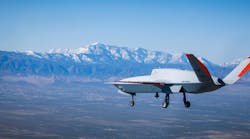Dec. 10--TRAVERSE CITY -- Amazon's idea to let self-guided drones deliver packages from warehouse to doorstep could make online retail soar someday, but its ambitious timeline may not fly.
"I just don't see how the whole Amazon idea will work with the FAA regulations" said Tony Sauerbrey, who heads up Northwestern Michigan College's unmanned aerial systems program. "They're talking about these UAVs zinging off in a 10-mile range. Although technically possible, safety and regulatory reasons will prevent it for quite awhile."
Amazon CEO Jeff Bezos showed a video demonstration of a drone delivery on a recent 60 Minutes segment. He said his octocopters might look like something out of science fiction, but there's no reason they can't be used as delivery vehicles within four to five years.
Bezos said the drones can carry packages that weigh up to five pounds, which covers about 86 percent of the items Amazon delivers. The 10-mile range would cover a significant portion of the population in urban areas, Bezos said.
Unlike the drones used by the military, Bezos' proposed flying machines won't need humans to control them remotely. Amazon's drones would receive a set of GPS coordinates.
But Sauerbrey said FAA regulations require a human to keep a UAV in complete control and within sight at all times. In point of fact, the FAA doesn't yet allow any commercial use of drones with approval still a year or two away, Sauerbrey said.
Besides the regulatory challenges, "sense and avoid" technology must still be refined so the aircraft can sense other drones, airplanes, antennas, hills and buildings, Sauerbrey said.
Yet Sauerbrey lauded the report for providing a glimpse into drones' enormous potential, ranging from crop surveys to collecting images of hard-to-reach places like wind turbines. There's still a stigma to drones, with many people associating them with spy vehicles, Sauerbrey said.
"It goes with the term 'drone,'" said Sauerbrey, who much prefers the term UAV. "Because it's a new technology and the military has used them for surveillance, people tend to think it's the only reason for it. It's similar to airplanes. The military has spy planes, but it doesn't mean every plane is a spy vehicle. Hopefully, people will start to see this differently. It can do amazing jobs, increase safety and efficiency, and still operate within privacy limitations and safety regulations."
Sauerbrey said that driverless delivery cars might be a quicker route than drones.
"They're very much on the horizon," he said. "Your UPS delivery truck may not have a driver in it."
There are about 45 students in NMC's UAS program, one of about six in the country, Sauerbrey said.
The ASSOCIATED PRESS contributed to this report.
Copyright 2013 - The Record-Eagle, Traverse City, Mich.
